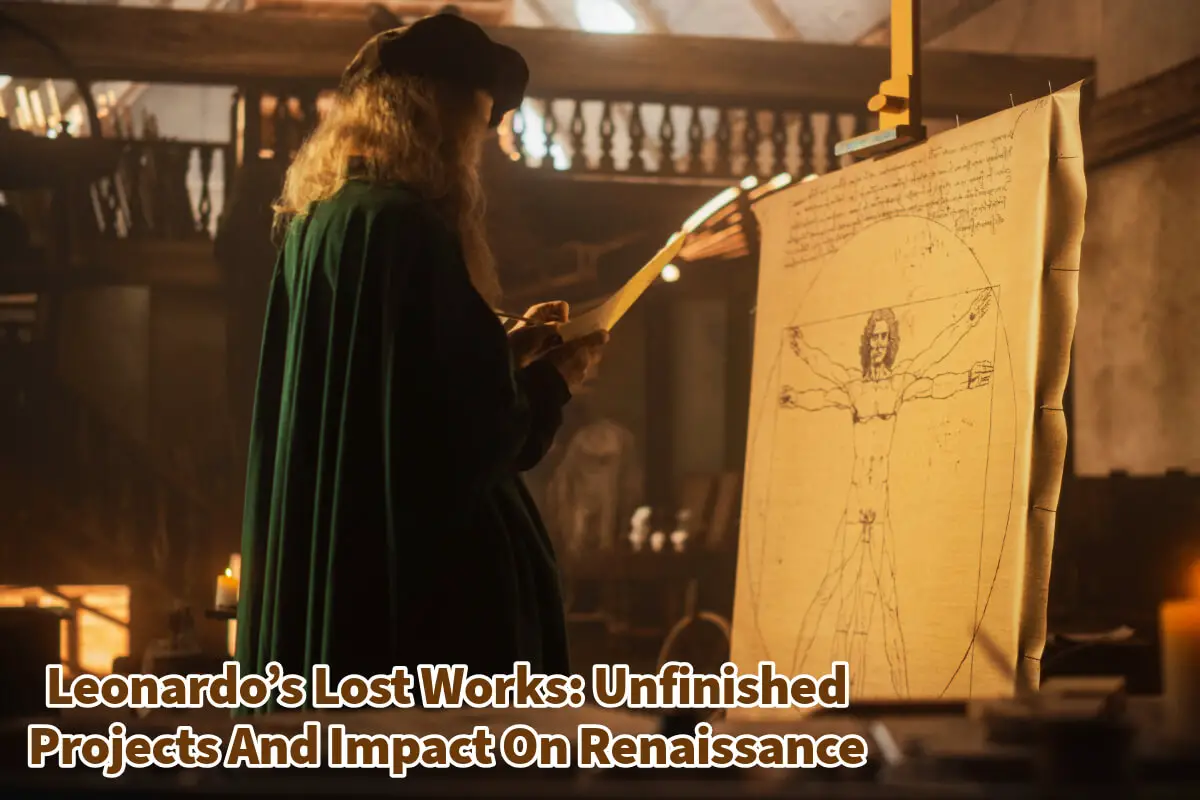Leonardo da Vinci is regarded as one of the most diversely talented individuals in history, embodying the quintessential Renaissance man with his boundless curiosity and expertise across multiple fields.
While Leonardo produced some of the most iconic works of the Renaissance, such as the “Mona Lisa” and “The Last Supper,” a significant portion of his creative genius remains elusive, encapsulated in unfinished projects, lost paintings, and incomplete treatises. Despite the scarcity of physical evidence and the incompleteness of much of his work, Leonardo’s influence on future generations of artists, scientists, and thinkers is profound.
Table of Contents
- The Enigma of Leonardo’s Unfinished Projects
- Leonardo’s Unfinished Paintings
- Unfinished Sculptures and Architectural Projects
- Leonardo’s Unfinished Treatises
- The Impact of Leonardo’s Unfinished Works on the Renaissance
- Related Questions
Read on as we delve into Leonardo’s unfinished works—his lost paintings, incomplete sculptures, and unfulfilled treatises—and explore how these missing pieces of his genius shaped the Renaissance and laid the foundation for future innovation.
Even though many of his creations were left unfinished, Leonardo’s visionary approach continues to inspire and intrigue, leaving an indelible mark on the world.
The Enigma of Leonardo’s Unfinished Projects
Leonardo da Vinci’s working process was characterized by an almost obsessive attention to detail and a reluctance to finish projects. This may seem paradoxical for someone considered a master of the Renaissance, but Leonardo’s meticulous approach often led him down intellectual and technical rabbit holes.
His desire to perfect each element of his work led to frequent delays, which, combined with his insatiable curiosity, meant many projects were incomplete.
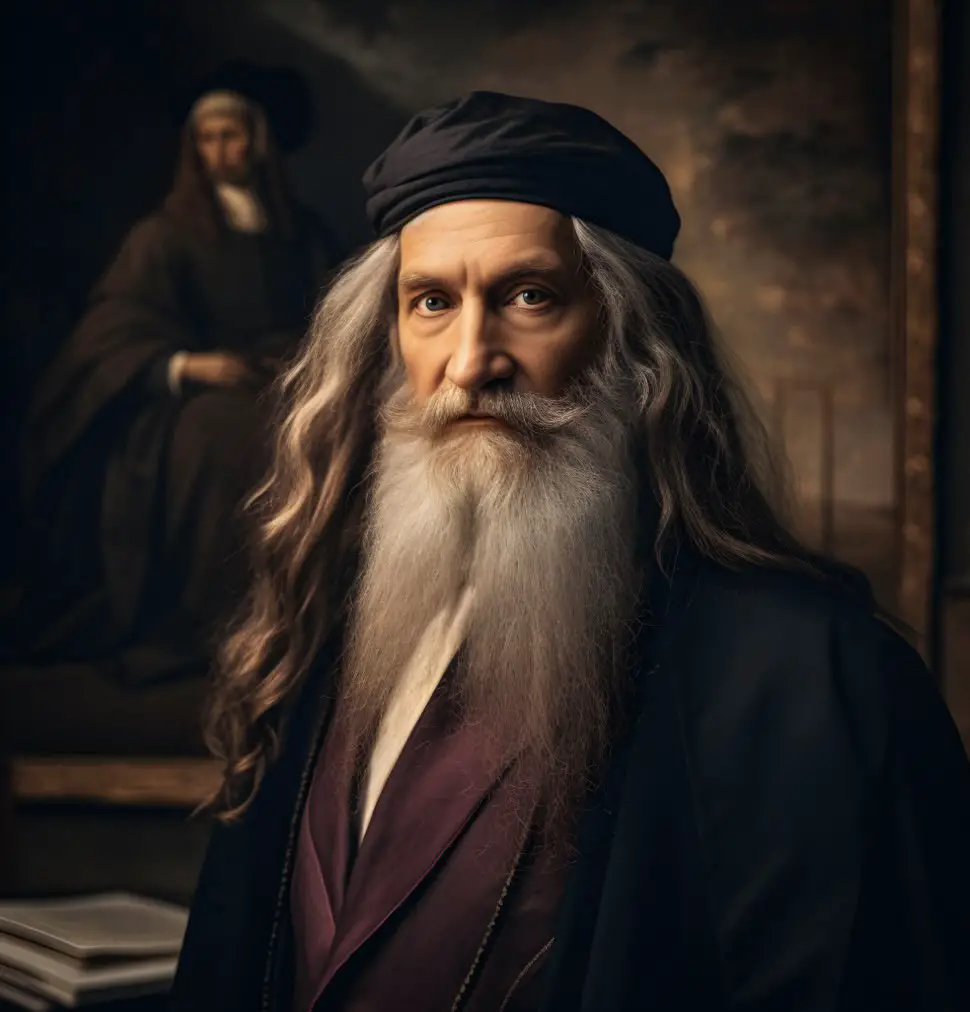
4 Reasons Why Leonardo Had Uncompleted Projects
There are several reasons why Leonardo’s projects remained unfinished. Some of the main reasons include:
Perfectionism:
Leonardo’s desire for perfection often led him to spend years on preliminary studies, sometimes abandoning the final execution altogether.
Distraction:
Leonardo’s diverse interests often led him to begin a new endeavor before completing an existing one. His notebooks reveal ideas spanning anatomy, engineering, botany, physics, and art.
Technical limitations:
Leonardo’s experiments in art, particularly his use of new materials and techniques, sometimes backfired, causing projects to deteriorate or fail prematurely, as seen with “The Last Supper.”
Mind Always Working
Leonardo da Vinci was known for his extraordinary mind, constantly engaged in thought. His keen sense of observation allowed him to notice details that others might overlook, prompting him to record his insights and explore them further through study and experimentation.
Leonardo’s Unfinished Paintings
While Leonardo is most famous for his paintings, many of his works remain either unfinished or lost to history. These incomplete projects hint at what could have been and illuminate Leonardo’s artistic process and influence on other artists of the period.
The Battle of Anghiari
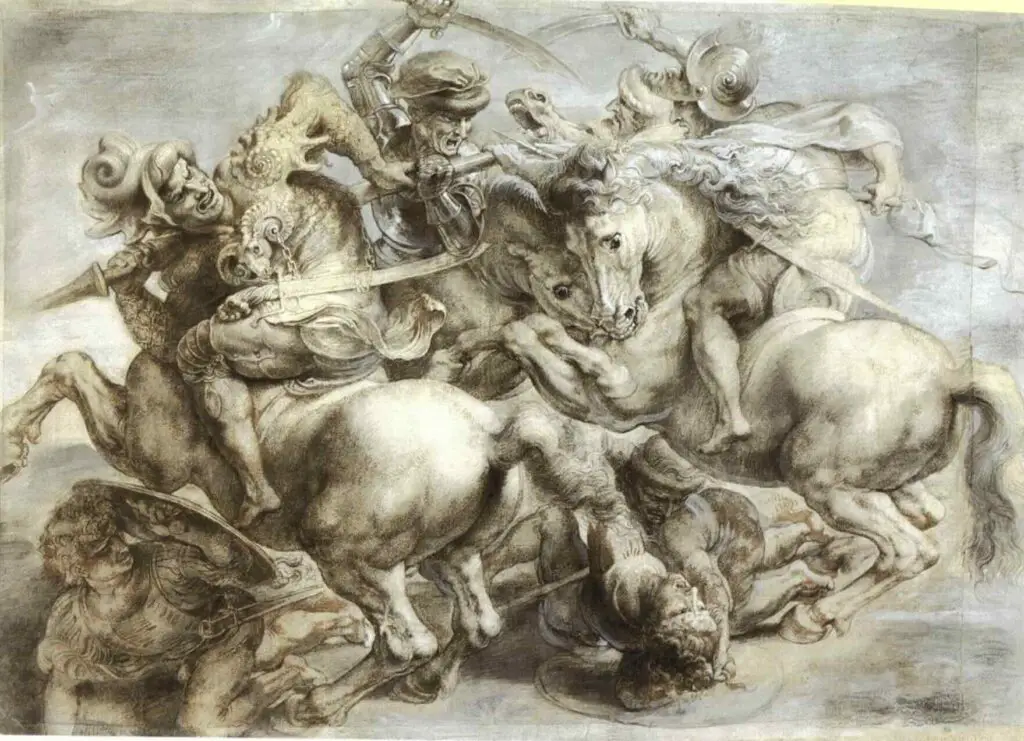
One of Leonardo’s most ambitious, yet ultimately unfinished, works was “The Battle of Anghiari.” Commissioned by the Florentine government in 1503, the painting was intended to decorate the Great Council Hall of the Palazzo Vecchio in Florence.
The painting depicted a dramatic scene from a 15th-century battle between Florence and Milan. Leonardo designed the composition to show a dynamic, chaotic struggle between soldiers, with horses rearing and figures contorted violently.
However, Leonardo’s desire to experiment with new techniques led to the work’s downfall. He attempted to use an experimental fresco method, which ultimately failed, causing the painting to deteriorate before it could be completed.
Despite this, “The Battle of Anghiari” had a lasting impact on the artists who saw its preliminary sketches and cartoons (large preparatory drawings). Michelangelo, Raphael, and Peter Paul Rubens were mainly influenced by Leonardo’s depiction of intense human emotion and dramatic movement, elements that would become central to the Mannerist and Baroque styles.
Saint Jerome in the Wilderness

Another of Leonardo’s unfinished masterpieces is “Saint Jerome in the Wilderness,” a painting he began in the 1480s. This work portrays Saint Jerome during his penance in the desert, a powerful image of human suffering and spiritual reflection.
The painting is only partially completed, with some areas more developed than others, giving us a rare glimpse into Leonardo’s working process.
“Saint Jerome in the Wilderness” reveals Leonardo’s deep understanding of human anatomy and emotion. The saint’s gaunt figure, hollowed by fasting and prayer, is depicted with anatomical precision, showing the influence of Leonardo’s studies of the human body.
Although left unfinished, this painting foreshadows many stylistic elements that would define the High Renaissance: realism, emotional intensity, and a focus on the individual’s inner life.
Salvator Mundi: Restored but Controversial
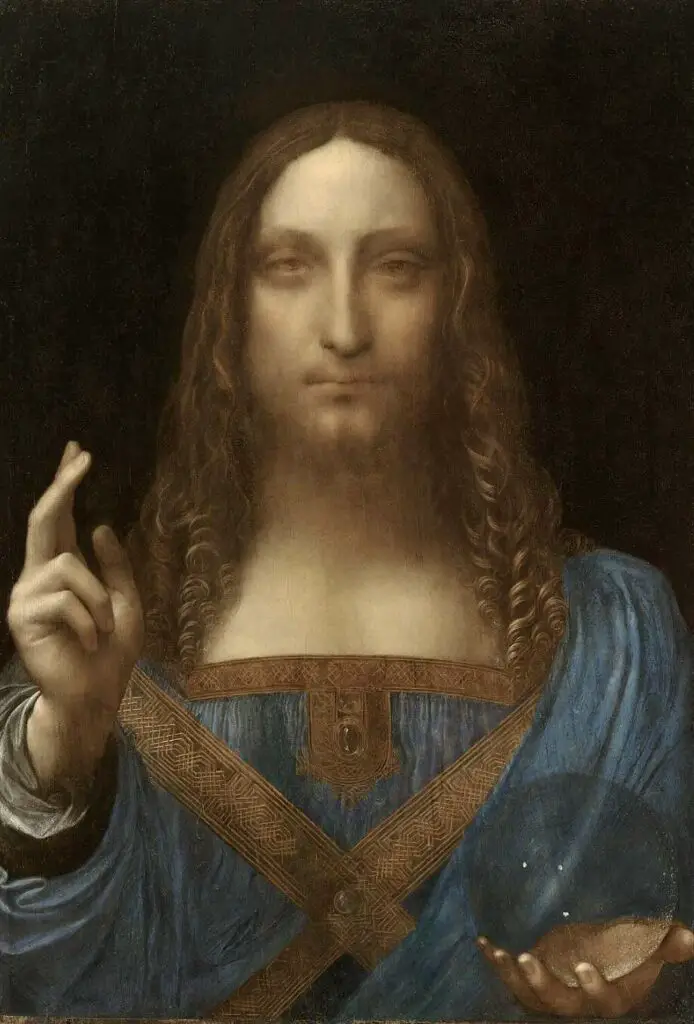
Perhaps one of Leonardo’s most famous (and controversial) lost or unfinished works is the “Salvator Mundi.” This painting, depicting Christ as the “Savior of the World,” was believed lost for centuries until it was rediscovered and restored in the 21st century.
The painting’s heavily restored condition has led to debates over whether it is an authentic Leonardo or a product of his workshop.
Despite the debate surrounding the painting’s provenance, “Salvator Mundi” encapsulates many issues plaguing Leonardo’s surviving works.
So few of his original paintings have survived in their true form that distinguishing the master’s hand from his pupils’ is often challenging. The layers of restoration obscure Leonardo’s genius, leaving us with a fragmented understanding of his artistic legacy.
The Adoration of the Magi
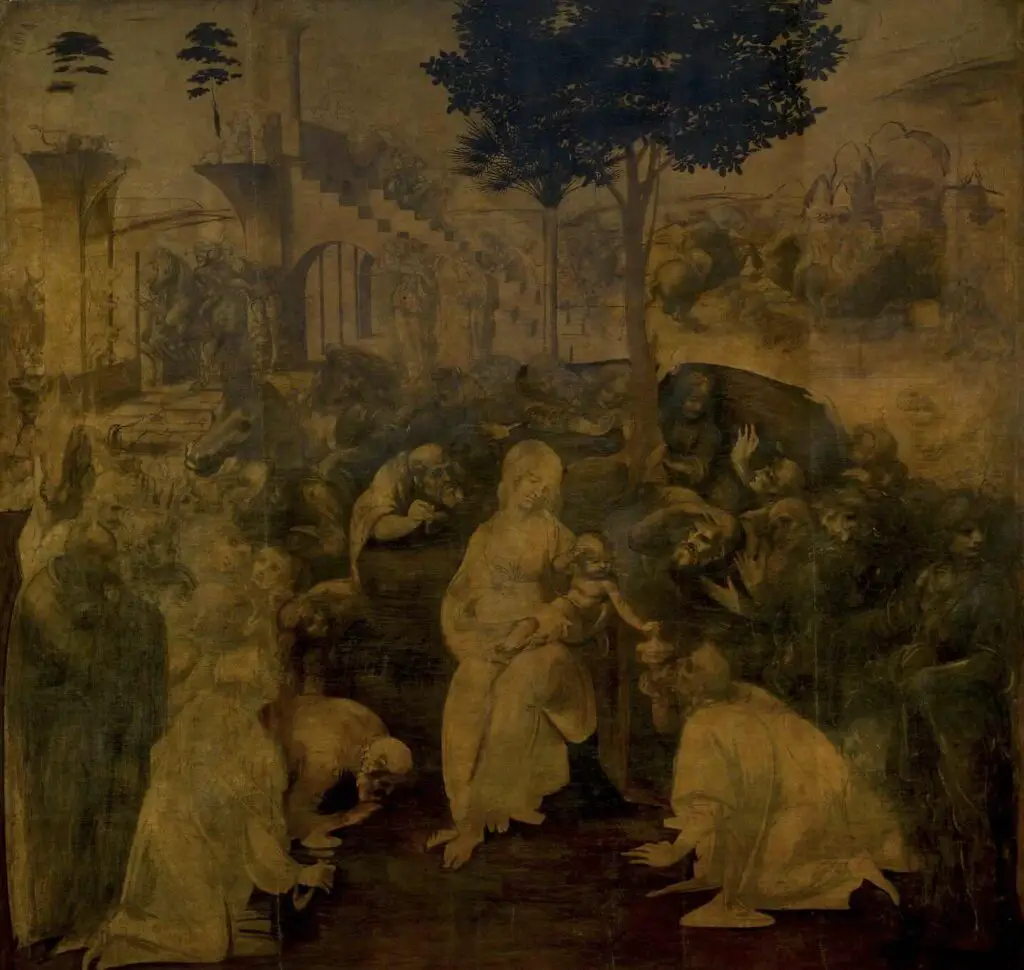
Another of Leonardo’s unfinished paintings, “The Adoration of the Magi,” reveals his ambitious approach to composition and his desire to push the boundaries of Renaissance art.
Commissioned in 1481, the painting was intended to be a grand, complex depiction of the biblical story of the Magi’s visit to the infant Christ. However, Leonardo left the work unfinished when he departed Florence for Milan in 1482.
The unfinished nature of “The Adoration of the Magi” allows us to see Leonardo’s underlying composition, with figures sketched but not fully realized.
Despite its incomplete state, the painting’s dynamic arrangement and use of perspective were groundbreaking for its time. They influenced contemporaries like Sandro Botticelli and later artists such as Caravaggio, who admired Leonardo’s ability to capture movement and emotion.
Unfinished Sculptures and Architectural Projects
In addition to his incomplete paintings, Leonardo left behind numerous unfinished sculptural and architectural projects. While never realized, these projects offer insights into his visionary approach to art and engineering.
The Sforza Horse

One of Leonardo’s most ambitious yet unrealized projects was the massive equestrian statue called the “Sforza Horse.” Commissioned by Ludovico Sforza, the Duke of Milan, in 1482, the statue was intended to be the largest equestrian monument ever created, standing over 24 feet tall.
Leonardo spent years designing the statue, creating detailed sketches and engineering plans for casting the massive bronze structure.
Unfortunately, the project was never completed due to political and financial upheaval. When the French invaded Milan in 1499, the clay model that Leonardo had spent years perfecting was destroyed, and the bronze intended for the statue was repurposed for weapons.
Despite its unfinished state, the “Sforza Horse” had a lasting influence on the history of sculpture. Leonardo’s innovative design and engineering techniques were studied by later artists, and in 1999, a full-scale version of the statue based on Leonardo’s original designs was completed in Milan.
Architectural Visions
Leonardo’s genius also extended to architecture, though none of his projects were fully realized. His notebooks contain elaborate designs for cathedrals, fortresses, and even ideal cities.
One of his most intriguing architectural projects was his design for a “centrally planned church,” inspired by his studies of geometry and proportion. These designs reflected Leonardo’s belief that architecture, like art and science, was governed by mathematical principles and should harmonize with the natural world.
While these architectural projects remained on paper, they influenced the development of Renaissance architecture, particularly in their emphasis on symmetry, proportion, and harmony. Architects such as Donato Bramante and Michelangelo drew inspiration from Leonardo’s visionary designs, incorporating his ideas into their masterpieces.
Leonardo’s Unfinished Treatises
Perhaps the most significant of Leonardo’s unfinished projects are his numerous treatises, which he intended to compile on subjects ranging from anatomy to painting to mechanics. If completed, these treatises would have revolutionized Renaissance science and art.
Unfortunately, Leonardo’s perfectionism and constant revisions meant that most of these works remained unfinished and scattered throughout his notebooks.
Treatise on Anatomy

Leonardo’s studies of human anatomy were groundbreaking. He combined his artistic skills with his scientific curiosity. He conducted numerous dissections of human cadavers, meticulously documenting his findings in his notebooks.
His anatomical drawings are among the most accurate of the Renaissance, revealing a deep understanding of the human body’s structure and function.
Leonardo intended to compile these studies into a comprehensive “Treatise on Anatomy,” which would have been the most advanced anatomical text of its time. However, the treatise was never completed, and his anatomical discoveries were not widely known until centuries later.
Despite this, Leonardo’s anatomical studies influenced later artists and scientists, including Andreas Vesalius, whose work on anatomy is often credited with revolutionizing the field.
Treatise on Painting

Leonardo also planned to write a “Treatise on Painting,” which would have codified his artistic theories and techniques. This treatise was intended to guide artists, outlining principles of perspective, composition, and light.
While the treatise was never completed, parts of it were compiled and published posthumously, influencing generations of artists.
Leonardo’s unfinished “Treatise on Painting” reflects his belief that painting was both a science and an art, governed by the same laws of nature that applied to other disciplines. His emphasis on observation, anatomy, and the study of nature profoundly impacted Renaissance artists, who sought to emulate his meticulous approach to representation.
The Impact of Leonardo’s Unfinished Works on the Renaissance
Despite leaving so many projects unfinished, Leonardo da Vinci’s influence on the Renaissance and future generations is undeniable. His visionary ideas, even in their incomplete state they pushed the boundaries of what was possible in art, science, and engineering.
Influence on Renaissance Artists
Leonardo’s unfinished works, particularly his paintings and sketches, had a profound impact on his contemporaries and later artists. His innovations in composition, movement, and emotional expression were revolutionary, inspiring artists such as Michelangelo, Raphael, and Titian. Even in their incomplete form, Leonardo’s works provided a blueprint for how art could capture the complexity of the human experience.
Influence on Science and Engineering
Leonardo’s unfinished treatises and inventions also had a lasting impact on the development of science and engineering. His studies of anatomy, hydrodynamics, and mechanics were centuries ahead of their time, influencing fields as diverse as medicine, physics, and architecture.
While many of his ideas were not fully realized during his lifetime, they laid the groundwork for future discoveries and innovations.
Leonardo da Vinci’s unfinished works offer a glimpse into the mind of one of history’s greatest geniuses. While many of his projects remain incomplete, their influence on the Renaissance and future generations cannot be overstated.
Leonardo’s relentless pursuit of knowledge, his innovative approach to art and science, and his belief in the interconnectedness of all things continue to inspire and captivate us today. Even in their unfinished state, his works remind us of the limitless potential of human creativity and the enduring power of curiosity.
Anita Louise Art is dedicated to art education, great artists, and inspiring others to find and create their art. We love art that uplifts and inspires. #ArtToMakeYouSmile! #ArtToMakeYouHappy!
If you want to see any of my art, you can find out more by clicking here. If you are interested in what inspires me and my paintings, you can discover more by clicking here.
We have a free newsletter and would love you to be part of our community; you can subscribe to the newsletter by clicking here. If you have any questions, I would be happy to talk to you. You can reach me, Anita, by clicking here.
Subscribe to our Anita Louise Art YouTube Channel, filled with great videos and information by clicking here.
Join us for our podcast “5 Minutes With Art.” Spend just 5 minutes a week with us to discover and learn about great art and artists. You can find out more about our podcast by clicking here.
Related Questions
What Was The Focus Of Renaissance Art?
The focus of Renaissance art was on the classics of Greek and Rome, humanist philosophy, and the study of the human figure. Realism was also an essential part of renaissance art. The great artists of the Renaissance also became great anatomists and studied human beings.
By clicking here, you can learn more by reading What Was The Focus Of Renaissance Art?.
What Is The Importance Of Art From The Renaissance Period?
Renaissance art is essential as it was a time of rebirth and discovery. Artists like Leonardo da Vinci, Michelangelo, and Raphael were at the forefront of that change, creation, and discovery. Renaissance art has influenced art and artists for many centuries and continues to influence artists today.
By clicking here, you can learn more by reading What Is The Importance Of Art From The Renaissance Period?.
21 Top Renaissance Artists And Their Works Of Art
When we speak of top Renaissance artists, we think of the trinity of artists like Leonardo da Vinci, Michelangelo, and Raphael. But besides these three artists, many other influential Renaissance artists remain essential.
By clicking here, you can learn more by reading 21 Top Renaissance Artists And Their Works of Art.

